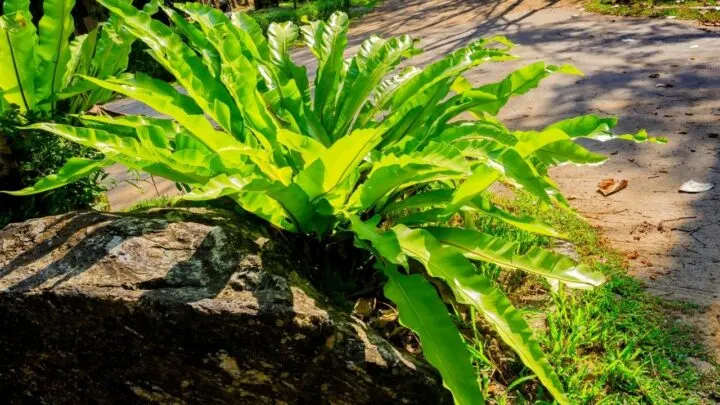Asplenium nidus, also known as a Bird’s Nest Fern, is a tropical plant usually found growing in high curves of rainforest trees.
They are native to Asia, Australia, Madagascar, Hawaii, and Polynesia but can be grown in the comfort of your own home.
At their mature size, Bird’s Nest Ferns can grow up to 3-5 feet tall and 2-3 feet wide.
Unfortunately, ferns are not the easiest plants to grow, and even seasoned plant parents sometimes struggle to keep these beauties alive. This is a pity as these plants are great additions to apartments and are non-toxic and safe for cats.
If yours is having a hard time as well, read on to find out what you can do about it!
Why is My Bird’s Nest Fern Dying?
Providing a Bird’s Nest Fern with proper temperature, moisture, and humidity is extremely important in order to keep it alive and healthy. Improper watering, drainage, humidity, or pests are just some of the reasons why your Bird’s Nest Fern may be struggling to stay alive.
Reasons Why Your Bird’s Nest Fern is Dying
Improper Lighting
Bird’s Nest Ferns can grow very well in filtered sunlight and can handle a moderate amount of shade.
But, if you grow this plant in a low-light area, it will result in slower growth, due to the fact that it can not photosynthesize as well as it could with proper sunlight.
However, if you expose this plant under direct sunlight, the scorching heat burns the leaves, ultimately causing them to start yellowing.
When growing a Bird’s Nest Fern indoors, a north or east-facing window is the best option in order to avoid any sun damage.
Improper watering
This type of fern does prefer consistent soil moisture, but they do not do well sitting in very wet soil. When you feel that soil’s top inch starts drying out, then that’s the sign that the plant needs some watering.
When watering a Bird’s Nest Fern, make sure to avoid watering directly in the center of the plant as this can cause mold growth.
The best method is to water just the soil, in order to avoid getting water on the plant itself.
You should plant the Bird’s Nest Fern in a container with drainage holes. Without that, the soil will not be able to properly drain and you risk root rot.
In order to keep them healthy, these plants love soil that’s high in organic material and proper drainage.
Making your own soil mixture with draining additives, such as perlite, will help reduce wet, soggy soil.
Failure to Maintain Ideal Temperature
Bird’s Nest Ferns typically thrive in temperatures between 60 and 80 degrees Fahrenheit.
Although they can withstand temperatures down to 50 degrees Fahrenheit, anything lower than that can cause distress, specifically with extended exposure
Keeping these ferns in temperatures lower than 50 degrees increases the risk of shock.
However, plant shock can be due to any abrupt changes in its environment.
Aside from temperature changes, water stress, over-fertilizing, or even changes in light can shock a plant.
Incorrect Humidity Levels
This type of fern thrives in high humidity. Typically, Bird’s Nest Ferns can live in 30-50% humidity, but adding more will help reduce their edges from browning.
There are various ways for you to make the room more humid for your Bird’s Nest Fern if the current house environment doesn’t offer one yet.
To do so, you can use a humidifier or a pebble tray. However, a humidifier is the most efficient way to maintain the humidity level your plant needs.
If you are going to use the pebble tray method, ensure that there’s no water sitting at the bottom of the pot.
If the bottom of the pot is sitting in water for an extended period of time, it can cause the plant to obtain root rot.
Plant Pests
Thankfully, these plants are not very susceptible to any serious diseases or pests, although they can be affected by certain common pests such as scale.
However, weak plants that are not receiving the care they need are more susceptible to pest infestations.
To reduce pest damage, ensure your Bird’s Nest Fern receives proper lighting, nutrients, and consistent watering.
Another thing you can do is inspect the top and bottom leaves of your Bird’s Nest Fern to ensure no pests are hiding.
If you do find any pests, insecticidal soap or natural home remedies, such as a neem oil mixture, will help reduce your infestation.
You can read our detailed article about how to use neem oil on houseplants.

Daniel has been a plant enthusiast for over 20 years. He owns hundreds of houseplants and prepares for the chili growing seasons yearly with great anticipation. His favorite plants are plant species in the Araceae family, such as Monstera, Philodendron, and Anthurium. He also loves gardening and is growing hot peppers, tomatoes, and many more vegetables.


